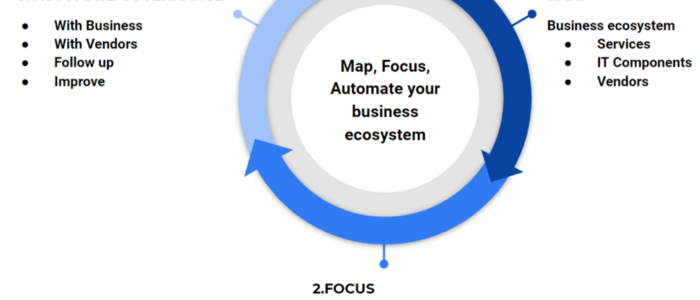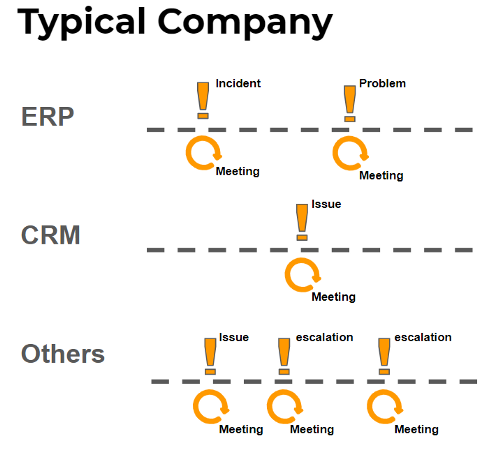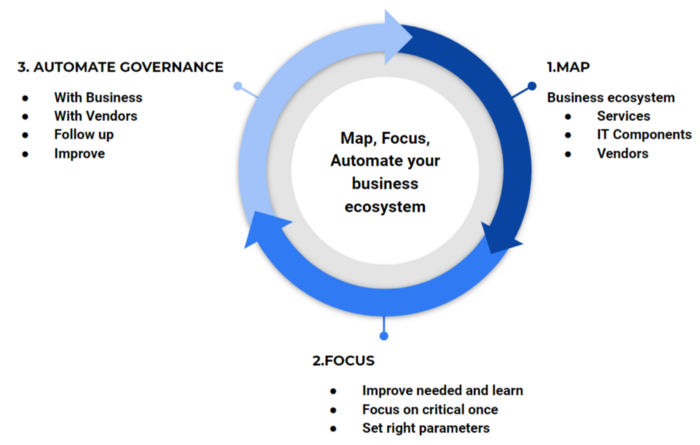Digitalization and cloud business models bring new challenges in service management

New market trends, changing customer behaviour and new business models and technologies impact companies and the way they operate nowadays. One impact is quite important, yet less visible one, covering management and governance of the business itself. Increasing complexity of internal products, services and processes, significantly growing number of vendors, external services, and business models together with fragmentation and hybridization of the business (not just IT) infrastructure makes standard operating practices and process difficult to use, as we inevitably shift from the old one-vendor-lock-in delivery model to mix of fragmented cloud and onsite services.
Learn and manage business expectations
Internal dialogue between business and IT becomes even more important now. The key is focus and different quality levels. You need to know which of the vast majority of services are the critical ones and set them the right parameters. The rest “can wait”. Otherwise, you overload everybody with unimportant information and miss the crucial ones.
You should regularly meet your business stakeholders, discuss the priority services and check their expectations towards costs. Do they really need that email campaign service with 99,99% availability and rapid latency? What happens if customers gets email 10 minutes later? Nothing, right? So, why to pay fortune for that! But what about that ordering portal? Yes, this is more important and requires more attention, not just the availability, but also latency, reliability and data security…
Such type of discussions should be part of the daily business and common routine between business and IT teams.
Same issue applies also to external vendors and services. Typical end-to-end business services build on top of core systems like ERP or CRM and provided by one vendor can now be accompanied by many small cloud services used by different departments and delivered by many vendors. Some of them can be respected companies, makers of the core system, some can be small nimble start-ups from all around the world.
IT and Security teams sometimes know about these small external services, sometimes don’t. Sometimes, they give the full responsibility to the department itself (e.g. marketing, sales, products, operations), sometimes they have headache considering the service quality, availability or data security departments can require from them (without any lever to the vendors).
Big corporations have at least some habits

Good news is, it works somehow for bigger corporations that are process-driven. They have 2 good habits.
First, they have internal processes requiring meeting business and IT representatives regularly with the goal to gather requirements, set the parameters, measure and improve. Lessons from the trenches differs from only formal meetings with no connection to business value (scattered over many departments, but just few meeting here), over detailed discussions and strong KPIs (again disconnected from real value) to really working cooperation driven by business users and real value.
Second, process-driven corporations build relationship with vendors by regular follow-ups and checks, but just with a few vendors of large and expensive systems like ERP, CRM or core domain specific tools (operations management, reservation system, etc.).
These routines are typically handled by ITSM or Procurement unit with support of some Vendor Management tool.
Therefore:
- There is no connection to the real value consumed by the business people using the service or even end customers,
- Responsible team doesn’t have the context and business knowledge (lacking big picture and value perception fragmented among many business departments),
- Responsible team is driven by different KPIs than the business one consuming the service value.
The consequence of such functional responsibility split is a separation of business users, negotiator and IT provider (but all internal teams). The situation is even worse in case of external vendors, as there is also strong role of Procurement unit, that is far away from value understanding and could easily miss the difference between price and value (e.g. skills, flexibility and ease of cooperation). They are not the ones who would daily work with the service or the vendor.
How would you answer these questions:
- Do we really need to use all the modules of core systems?
- Which one is the core for our business operations?
- How many “small cloud services” do we consume?
- How much do we pay for them?
These are the questions we are typically not able to answer, not mentioning acting on them. We process our basic governance tasks well: we meet our internal business stakeholders, IT teams, external vendors, we negotiate better parameters or prices, but does it bring the value to our company? Are the best parameters for all our business services bringing company the highest value? Is lower price of not needed module needed? Or is value the loss of vendor flexibility due to a lower price push? These things are unclear or scattered among different departments.
SMB and low enterprises struggle even more
Many smaller companies like low-enterprises and SMB don’t have this service governance process in place at all. They usually try to identify the services and contact internal IT or external vendor directly only when there is an issue or incident. When some application or service is not working, this is the first moment we think about the service parameters, IT team, external vendors, their contacts, we start to look for them, we ask for paid support etc. And typically, we try to find it somewhere… But where?!

Current trend of services fragmentation
Current market and technology changes are accompanied by service fragmentation and hybrid models being used. Typical company have mixture of internal providers and small external vendors for on-premise solutions with many online cloud services not just on business and marketing side, but also in technology and/or development department.
Fragmented mix of internal and external service components, cloud and on premise models, mix of many small vendors with few original big ones is current standard.
How to manage all these with the traditional approach? What is proven and validated practice, and what is not? Which components are business critical and which are not? Do we have the right monitoring, governance, and parameters (SLA) for the critical ones? Do we meet regularly internally and discuss the needs on business side, change service levels, their parameters and agree on improvements? And do we follow the same routine also with external providers?

It’s a simple routine: Map — Focus — Automate
To grasp current trends efficiently, you need to have a light-weight process with ideally simple supporting tool(s). Basically you need to cover just these 3 areas with your business, IT and external vendors:
- Establish platform for business and IT communication — this covers the initial phase of gathering, visualization and discussion about the service needs, their impact and criticality, needed parameters, costs, evolution. Of course, it is important to check this regularly and update as the market conditions change.
- Focus on the right things, the rest can wait for now — knowing what part of business or IT infrastructure need to be improved and how, in the ocean of thousands services, components and inquiries from all the stakeholders and departments is the key. How? Based on what? Mapping and visualization of all the dependencies could help.
- Follow-up regularly and automate also the governance around these processes. It helps you to plan, track and follow actions and events among all levels of services and vendors, internal, as well as external.
Sounds simple, but not as easy to implement. Therefore, we described mentioned scenarios more in the details here:


